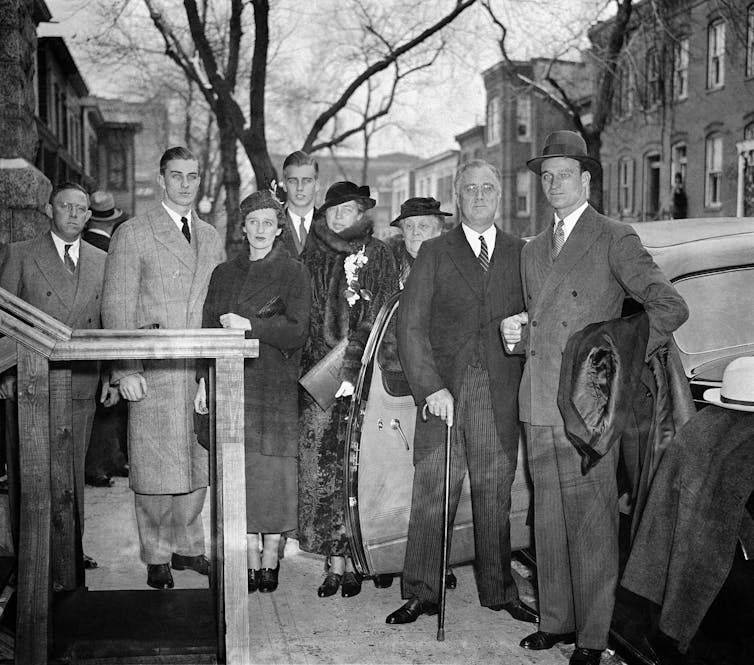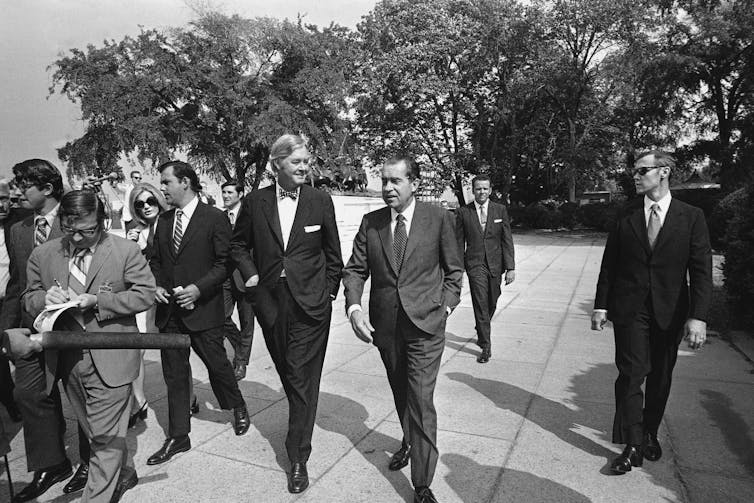Biden's goal to permanently boost support for families echoes a failed Nixon proposal from 50 years ago – will it take off this time?
- Written by Leslie Lenkowsky, Senior Counsellor and Professor Emeritus of Practice in Philanthropic Studies, Lilly Family School of Philanthropy, IUPUI
In July 2021, households with up to 88% of all U.S. children[1] will get their first of six no-strings-attached monthly payment from the federal government.
The money comes from a temporary expansion of the child tax credit[2] in the Biden administration’s US$1.9 trillion COVID-19 relief package[3] enacted in March. For one year only, the government has increased the credit from $2,000 for children until they turn 17 to $3,600 for every child under 6 and $3,000 for those ages 6 through 17. It is also making this benefit available to low-income families without any other income and changing the way this money is dispatched.
Families will get monthly payments of either $300 or $250 per child from the Internal Revenue Service through the end of 2021, with the balance distributed at tax time in 2022.
For the first time in U.S. history, the government is establishing an allowance for families with children[4], ending the country’s status as an outlier among industrialized nations[5] in lacking such a benefit. But as a longtime scholar of welfare policy and civic engagement[6], who spent years working in the government and think tanks[7] studying controversies over earlier efforts to assist families in similar ways, I question whether the Biden administration will succeed at its goal of making this a long-term policy[8].
 President Biden signed into law a COVID-19 relief package on March 12, 2021, which included government payments for most U.S. families with children.
Olivier Douliery/AFP via Getty Images[9]
President Biden signed into law a COVID-19 relief package on March 12, 2021, which included government payments for most U.S. families with children.
Olivier Douliery/AFP via Getty Images[9]
Diverging paths
The rationale behind these allowances[10] is easy to understand.
In theory, workers in an efficient economy should earn what their labor is worth[11]. How many children or other dependents they have to support should not matter to their employers.
All countries also have a collective interest in the well-being of families, such as ensuring enough future doctors, soldiers and other kinds of employees enter the workforce. By subsidizing the costs of raising children, governments or charities can help foot the bill for what a market economy fails to pay for through wages and benefits.
Beginning in late 19th-century France[12], where the population had been depleted by a series of wars, both public and private funds sprang up to assist families. Those payments were typically small, but available to all households with children. In the case of privately run plans, benefits would support members of the sponsoring organizations. As the cost of social programs mounted in France and elsewhere during the 20th century, governments started to restrict eligibility to lower-income families.
The United States took a different path.
Initially many states made “mother’s pension[13]” assistance payments in the early 20th century, which were limited to the families who needed it.
The federal government began to offer a similar kind of aid when the Social Security Act of 1935, the cornerstone of American social policy, launched Aid to Dependent Children[14]. This national program made federal funds available to match state spending help children in households without working parents.
In time, as other parts of the Social Security Act, such as unemployment insurance[15], became more comprehensive and generous, government officials and politicians expected fewer families to require this assistance. They believed the program would eventually “wither away[16].”
That did not happen.
 Early in his presidency, Franklin D. Roosevelt, second from right and surrounded by members of his family, established a welfare program for Americans with children facing economic hardship.
AP Photo[17]
Early in his presidency, Franklin D. Roosevelt, second from right and surrounded by members of his family, established a welfare program for Americans with children facing economic hardship.
AP Photo[17]
Ending AFDC
By the 1960s, Aid to Families with Dependent Children, as it was then called, had become one of the nation’s most controversial social programs.
In times when jobs were plentiful and wages were rising, more households were seeking assistance[18] from it. Moreover, a growing share of these families were needy not because of the death or unemployment of the principal breadwinner, but because they were headed by single mothers[19] who were separated from their husbands or had not married before having children. They were disproportionately African American[20] as well.
In 1969, President Richard M. Nixon proposed replacing the program with a “Family Assistance Plan[21].” He was advised by Daniel Patrick Moynihan, a Harvard University professor and future senator from New York who supervised my research when I was a doctoral student there.
A four-person household with children that had no other income, regardless of the number of parents present, would have received $1,600 a year – worth nearly $12,000 today, after adjusting for inflation – with the amount gradually declining as earnings increased. In addition, families remained eligible for other kinds of benefits, such as Food Stamps[22] and Medicaid.
Although it was the centerpiece of the Nixon administration’s domestic policy, his Family Assistance Plan died after a long and acrimonious battle in Congress[23].
Liberals argued that the benefits proposed for households without any earned income were too small. Conservatives worried that the plan would weaken incentives for low-income people to get paid work. Groups claiming to speak for the poor opposed it, as did members of Congress from the mostly Southern states where a large share of the benefits would have flowed.
In 1996, with the support of then-Senator Joe Biden, Congress abolished Aid to Families with Dependent Children. In its place, it created a program called Temporary Assistance for Needy Families[24], through which states could help low-income households with children for no more than five years. The aim of the legislation was to get the heads of households with children – including single mothers – into the labor force. It was supposed to “end welfare as we know it[25],” as President Bill Clinton said.
 President Richard Nixon, center, accompanied by Daniel Patrick Moynihan – a member of his Cabinet who wanted most low-income American families with children to get government payments.
AP Photo[26]
President Richard Nixon, center, accompanied by Daniel Patrick Moynihan – a member of his Cabinet who wanted most low-income American families with children to get government payments.
AP Photo[26]
Will it last more than a year?
Today, somewhat ironically, the Biden administration has put forth – and Congress has enacted – a program very similar to the Nixon administration’s Family Assistance Plan[27].
The chief difference is that the value of the child tax credit will be phased out for families who earn high incomes[28]. That threshold is set at $112,500 for single parents and $150,000 for married couples. In contrast, Nixon’s proposed allowances were[29] mainly intended for poor and working-class families with kids.
When Congress begins considering extending the measure to 2025, as the Biden administration wants, I expect to see the same concerns that derailed the Nixon administration’s similar proposal. Robert Doar[30], president of the American Enterprise Institute, his colleague Scott Winship[31] and other conservatives[32] have already questioned whether more generous benefits for families could reduce incentives for parents to earn a living.
Some economists predict that the expanded child tax credit, combined with other measures, will help reduce the child poverty rate[33]. And yet many advocates on behalf of low-income Americans are wondering whether Biden’s new proposal goes far enough[34] because it would last only through 2025. Like many Democrats in Congress, they want it[35] to become a permanent feature of the safety net[36].
[Get the best of The Conversation, every weekend. Sign up for our weekly newsletter[37].]
To be sure, even with the 2021 expansion, the child tax credit’s impact will be limited. For example, a single-parent family with three very young children and no income will get $10,800 a year in benefits. Adjusted for inflation, that amounts to a little less money than Nixon proposed distributing to U.S. families with kids half a century ago.
A new chapter in an old debate over family policy is being written. Whether the outcome will be the same this time around will say a lot about how Americans now think about how the government should approach social policies – and society’s obligations to support families.
Article corrected to indicate that Moynihan represented New York in the Senate.
References
- ^ 88% of all U.S. children (www.irs.gov)
- ^ child tax credit (www.taxpolicycenter.org)
- ^ Biden administration’s US$1.9 trillion COVID-19 relief package (theconversation.com)
- ^ allowance for families with children (www.merriam-webster.com)
- ^ outlier among industrialized nations (www.oecd.org)
- ^ welfare policy and civic engagement (www.researchgate.net)
- ^ working in the government and think tanks (legacy.npr.org)
- ^ goal of making this a long-term policy (www.whitehouse.gov)
- ^ Olivier Douliery/AFP via Getty Images (www.gettyimages.com)
- ^ these allowances (www.brookings.edu)
- ^ workers in an efficient economy should earn what their labor is worth (www.proquest.com)
- ^ Beginning in late 19th-century France (www.encyclopedia.com)
- ^ mother’s pension (www.encyclopedia.chicagohistory.org)
- ^ Aid to Dependent Children (socialwelfare.library.vcu.edu)
- ^ unemployment insurance (www.investopedia.com)
- ^ wither away (doi.org)
- ^ AP Photo (newsroom.ap.org)
- ^ more households were seeking assistance (doi.org)
- ^ headed by single mothers (doi.org)
- ^ disproportionately African American (www.dol.gov)
- ^ Family Assistance Plan (doi.org)
- ^ Food Stamps (theconversation.com)
- ^ died after a long and acrimonious battle in Congress (www.jstor.org)
- ^ Temporary Assistance for Needy Families (theconversation.com)
- ^ end welfare as we know it (www.history.com)
- ^ AP Photo (newsroom.ap.org)
- ^ Nixon administration’s Family Assistance Plan (www.worldcat.org)
- ^ phased out for families who earn high incomes (www.kiplinger.com)
- ^ Nixon’s proposed allowances were (www.proquest.com)
- ^ Robert Doar (www.wsj.com)
- ^ Scott Winship (www.aei.org)
- ^ other conservatives (thehill.com)
- ^ will help reduce the child poverty rate (www.urban.org)
- ^ wondering whether Biden’s new proposal goes far enough (www.clasp.org)
- ^ they want it (www.bread.org)
- ^ permanent feature of the safety net (www.cnn.com)
- ^ Sign up for our weekly newsletter (theconversation.com)

















